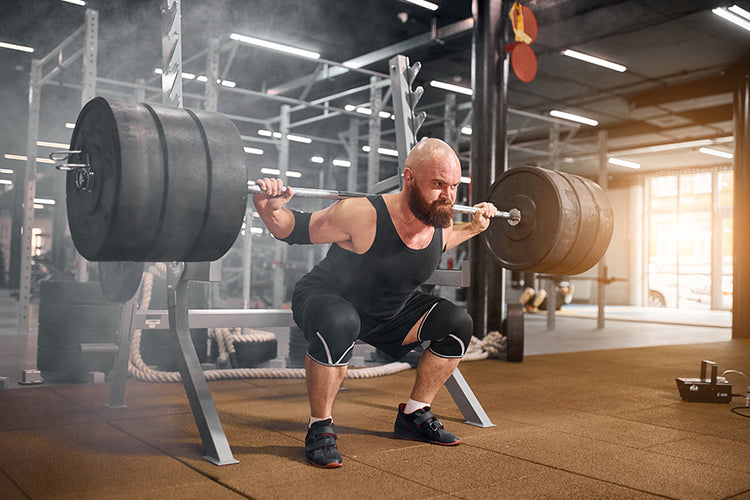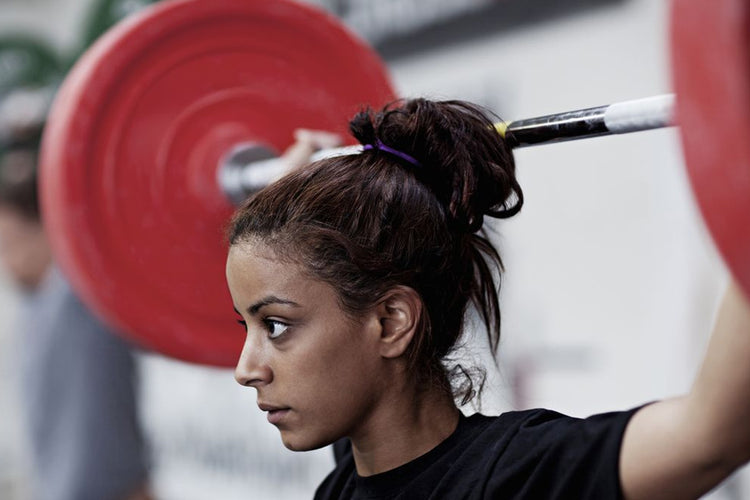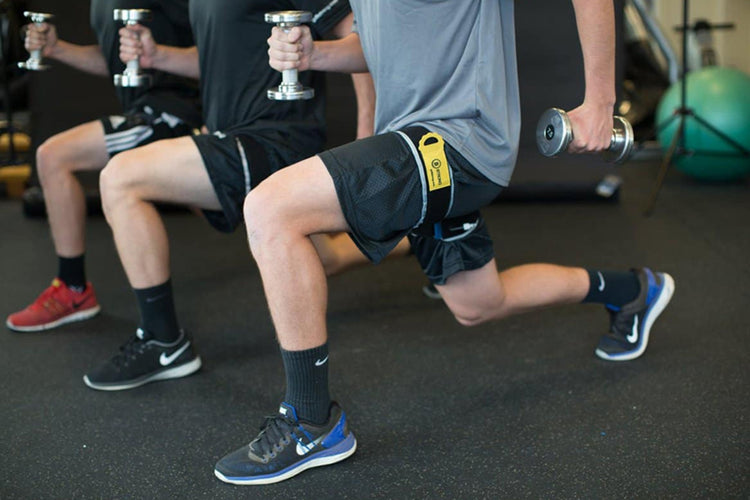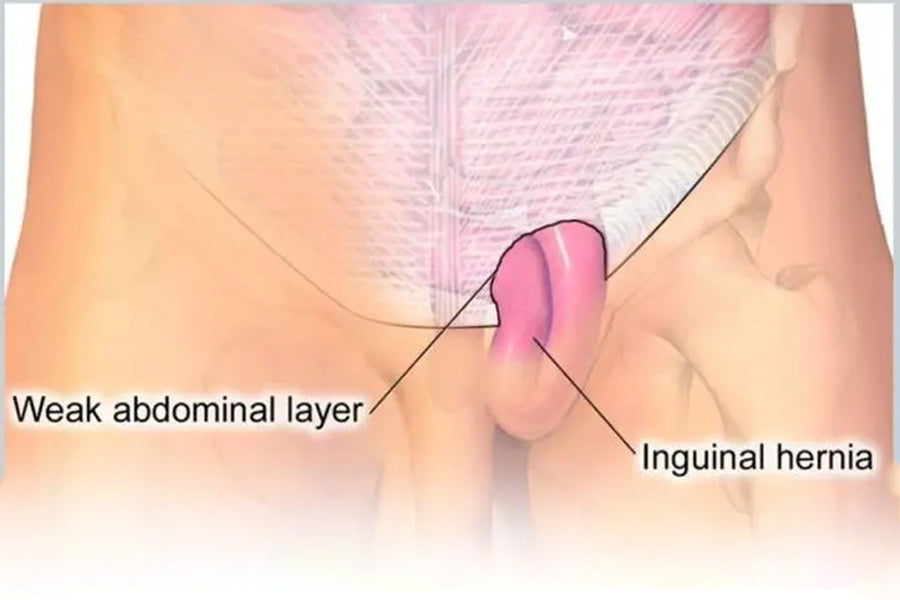Ah, the dreaded hernia. Every weightlifter's worst nightmare. That sudden and sharp pain that comes from nowhere leaves you doubled over and in agony. And the worst part? It could have been avoided if you had taken a few simple precautions. But fear not, dear reader, for I have come bearing knowledge that could potentially save you from this unfortunate fate.
Yes, you read that right. I am here to impart wisdom on weightlifting. And what better topic to tackle than hernias? Now, I know what you're thinking. "Oh great, another article is telling me what not to do. As if I don't have enough of those already."
But fear not, for this article is not just another dry list of do's and don'ts. No, this is a journey of discovery, a tale of intrigue, and a quest for knowledge.
So sit back, grab a protein shake, and get ready to learn how to avoid getting a hernia while lifting weights. I promise it won't be as painful as it sounds.
Unless you already have a hernia, you should see a doctor before attempting the exercises mentioned in this article. But for the rest of you, let's dive in and discover the secrets to a hernia-free weightlifting journey.
To prevent hernias, the initial step involves acquiring a fundamental understanding of their pathology and pathophysiology, which refers to what hernias are and how and why they happen.
Understanding these aspects is crucial since it will make the preventive measures more practical and significant. Consequently, a better comprehension of hernias will result in safer and less susceptible weightlifting.
What Exactly is a Hernia?
A hernia, or herniation, is characterized by an abnormal opening in a tissue wall through which an organ protrudes or bulges. Hernias can occur in various parts of the body. Still, this article focuses on inguinal hernias, the most well-known type of hernia among both lifters and the general population.
Inguinal hernias are characterized by a visible bulge in or around the groin area, which can cause concern for individuals looking to prevent this condition. Hernias can be symptomatic or asymptomatic, meaning they can cause noticeable pain and create a visible bulge.
While having a small tear in the abdominal wall may sound alarming, the current medical consensus suggests that surgical intervention for inguinal hernias is typically necessary only if they are painful.
Pain associated with inguinal hernias often occurs during intense abdominal contractions, such as coughing, sneezing, or bowel movements.
Here are four things you need to know to avoid hernia while lifting weights:
Related Article: Can Improving Your Immune System Help Getting Rid of Allergies? A Comprehensive Guide
1. Know Why Do Hernias Occur?
Despite many theories, no medical consensus exists on whether heavy lifting can cause inguinal hernias. Some believe the high pressure generated by the abdominal contents, specifically the small intestine, during heavy lifting or improper lifting techniques can push through the abdominal wall. This wall is responsible for keeping the small intestine in place.
It is vital to note that excessive pressure from the abdominal contents during heavy lifting often occurs with improper breath control and muscle activation of the abdominal muscles.
Many individuals can have an inguinal hernia without realizing it, as there are often no visible bulges or pain. Therefore, all lifters must know how to use proper technique and breath control when lifting, ensuring they do not worsen the herniation.
If high abdominal pressure is applied over a weak or torn abdominal wall area, the tear or bulge may become much more extensive, worsening the hernia.
Thus, it is essential to prevent or minimize hernias by understanding their nature and taking the necessary steps to avoid aggravating them. You can also take Post Workout Supplements to help prevent such situations and avoid injuries.
2. Know When and How to Use the Valsalva Maneuver Properly
The Valsalva maneuver can be an effective second line of defense to prevent a hernia while weight lifting. However, it is vital to note that the Valsalva maneuver may not be suitable for individuals with symptomatic or known hernias as it can exacerbate the condition. Remember to always consult your healthcare provider before engaging in this exercise.
It is crucial to exercise caution when performing the Valsalva maneuver, as individual factors need to be considered. If executed correctly, the Valsalva maneuver can protect the abdominal contents and prevent hernias and other related injuries.
This technique is considered an advanced breathing technique. It should only be implemented once the lifter has achieved technical proficiency in their compound lifts, such as squats and deadlifts, at moderate to moderately heavy loads.
What Is the Valsalva Maneuver?
The Valsalva maneuver is a powerful breathing technique that can help weightlifters and powerlifters increase their rigidity and stability during heavy resistance exercises like squats and deadlifts. You should also add Intra Workout Supplements to carry out better workouts with all aspects of stability, rigidity, and balance.
When performed correctly, this technique increases pressure throughout the abdominal cavity, activating the core musculature and increasing the rigidity of the spinal column. The Valsalva maneuver is an internal bracing technique that helps lifters maintain optimal form and prevent unwanted movements.
Why is maintaining a rigid torso and spinal column essential during heavy resistance exercises? All four of your limbs link back to your central area or core.
An unbraced core cannot effectively transfer power to other body regions, nor can it maintain the ability to resist unwanted movements. This means that if your core is not braced during a lift, you may not be able to generate the maximum amount of power possible, and you may be at risk of unsuccessful lifts or physical injury.
Furthermore, failing to brace your core during heavy resistance exercises can increase your risk of herniations in both your spinal discs and abdominal contents.
As you try to correct your positional deviation, more stress, strain, and shear can occur through your torso, potentially transferring unnecessary force to your abdominal wall. This tissue wall is relatively thin and the only structure holding your small intestine back, so avoiding putting too much stress on it is essential.
By using the Valsalva maneuver, you turn the midsection of your body into a strong pillar that is much better equipped to resist unwanted movements while moving weight with a high load.
This increased rigidity through your midsection and spinal column can prevent instability from occurring during your lift, even as the load becomes heavier and more challenging to control with optimal form.
So, for weightlifters and powerlifters looking to maximize their safety and performance, mastering the Valsalva maneuver is an essential skill that should be learned and practiced carefully.
Related Article: Common Powerlifting Meet Mistakes Made by Inexperienced Competitors
How to Perform the Valsalva Maneuver

To perform the Valsalva maneuver correctly, you need to bear down as if you had a bowel movement. This increases the pressure within your abdominal cavity and activates your core muscles, increasing the rigidity of your spinal column.
It's important to note that your stomach should not be pushing directly outwards when doing this, which indicates an incorrect technique that can place more significant amounts of stress on the abdominal wall.
It's also important to be aware of potential medical issues that could prevent you from safely performing this maneuver. Suppose you experience pain in or around your groin while performing the Valsalva maneuver. In that case, you may have an inguinal hernia, which requires medical evaluation and possibly avoiding the Valsalva for the time being.
During the Valsalva maneuver, you essentially can't breathe if you're trying to maintain maximal intra-abdominal pressure. This is because your glottis closes to prevent air from leaving your trachea, acting like a plug or valve to keep high pressure within your torso.
However, this breath-holding technique can be dangerous if done incorrectly. Holding your breath for too long while attempting to move and maintain a heavy load can result in lightheadedness, dizziness, or even passing out. You can take Multi-Vitamin Supplements for such techniques to maintain focus and energy.
Therefore, knowing how to implement this breath control technique correctly on each of your heavier lifts is crucial. You don't want to risk a hernia during a heavy lift, but you don't want to pass out and risk injury. With proper technique, the Valsalva maneuver can be a valuable tool for weightlifters and powerlifters to increase performance and reduce the risk of injury.
When to Perform the Valsalva Maneuver
The Valsalva maneuver is optional for every lifting situation. When lifting submaximal loads of 65% or less, there is less need for intra-abdominal pressure and spinal column stiffness. In such cases, a regular breathing pattern would be enough. The regular breathing pattern usually involves exhaling during the exertion phase of the lift.
Related Article: A Startup in Israel Is Detecting Cancer!
3. Know When and How to Wear and Use a Weightlifting Belt Properly
It's crucial to perform the Valsalva maneuver effectively before using a weightlifting or powerlifting belt. Wearing a weightlifting belt without knowing how to do the maneuver will not yield its maximal effect when correctly performed, and the lifter has reasonable control over his abdominal muscles.
Although using a weightlifting belt is debated in the lifting community, many agree that it can improve safety and performance when used correctly. However, it's essential to note that a weightlifting belt may not be helpful in certain hernias, like an inguinal hernia.
Nonetheless, many experienced lifters claim they experience less hernia-related pain and feel better while wearing a belt. Thus, considering the use of a weightlifting belt could enhance your training.
When Should You Wear a Weightlifting Belt?
To determine whether or not to wear a weightlifting belt, it's essential to consider your lifting mechanics for compound lifts like the squat and deadlift. Generally, wearing a belt is recommended when lifting around and above 70-75% of your one-rep maximum (1RM), although this can vary among established lifters.
For those using a belt to protect against hernias, paying attention to when intra-abdominal pressure builds during your lifts without a belt is essential. If you suspect you have a hernia, belting up may help reduce discomfort, but seeking medical advice is recommended if it doesn't.
If you don't have any herniation issues and feel healthy, you have more flexibility in deciding which loads to wear a belt for. However, it's important to remember that a belt protects against inguinal hernias and increases spinal and torso stability, which helps prevent spinal disc herniations.
How to Wear a Weightlifting Belt

When it comes to wearing a weightlifting belt, there are various types and styles to choose from, such as belts explicitly designed for Olympic weightlifting or powerlifting, and differing widths, thicknesses, and fastening mechanisms.
However, regardless of the type or style of belt you choose, the principles for wearing them optimally for safety and performance are generally the same.
Firstly, the belt should sit just above your hip bones. This location allows the belt to support your lower back and abdominal muscles during the lift.
Before tightening the belt, take a deep breath and push your stomach out as if preparing to bear down. This will ensure that when you tighten the belt, it presses against your abdominal muscles, providing additional support and stability.
When it comes to preventing hernias, wearing a belt in this manner allows it to act as a reinforcement for the abdominal wall. During the strenuous portion of the lift, excessive outward bulging of the abdominal wall can occur, which can cause abdominal contents, such as the small intestine, to push through the thin abdominal lining and cause a hernia.
However, when the belt is securely in place and pressing against the abdominal muscles, this excessive outward bulging is prevented. The belt reinforces the abdominal wall itself, preventing hernias from occurring.
4. Know How to Get Muscular and Stronger Without Going Heavy
Although taking the above mentioned precautions can significantly reduce the risk of weightlifting-related hernias, there are still instances where lifting heavy may not be suitable for a given lifter due to hernias or other factors. It is essential to practice heavy lifting with proper technique and precaution to maintain the longevity of muscles, tendons, bones, joints, and intestines.
This is particularly important as not all lifters, specifically those new to weightlifting, possess the confidence or technical proficiency to execute their lifts under heavy loads or endure high volumes of heavy lifting.
In addition, some lifters may have a predisposition to hernias or have pre-existing hernias that require careful consideration. For those who fall into these categories, there are still plenty of ways to train effectively without resorting to heavy lifting, or at least not lifting heavy as frequently.
Even the most accomplished and experienced lifters do not engage in heavy lifting every training session throughout the year. Therefore, it is advisable to follow in their footsteps by exploring alternative ways to challenge your body without putting excessive stress on it.
By avoiding heavier loads requiring higher levels of intra-abdominal pressure, including the Valsalva maneuver, the likelihood of sustaining a hernia or exacerbating an existing herniation can be significantly reduced.
Related Article: Upgrade Your Regular Weight Lifting to Strongman Training
How to Get Bigger and Stronger Without Lifting Heavy
Over the past few decades, much scientific research has been conducted on training methodologies that can enhance muscular size and strength without relying on traditional heavy loads.
This is good news for those who wish to avoid high intra-abdominal pressures during training, especially for those who have had previous encounters with hernias or wish to prevent them from worsening.
One way to increase muscle size and strength is through tempo-based training, where a deliberate tempo is used during an exercise's lifting and lowering phases. This can increase time under tension and promote muscle hypertrophy without needing heavier weights.
Another option is blood flow restriction training, which partially restricts blood flow to the working muscles during exercise. This leads to metabolic stress and promotes muscle growth and strength gains while reducing the need for heavy lifting.
Both methods effectively challenge and exert the muscles while maintaining proper form and reducing the risk of hernias or exacerbating existing ones.
Tempo-Based Training

Tempo-based training is a technique that can be used with any type of lift. Still, it's especially beneficial for exercises like squats and deadlifts that create high levels of intra-abdominal pressure.
This training can help you get bigger, stronger, and mentally more challenging, so don't discount it just because it uses lighter weights.
You must lift lighter loads much slower than usual to perform tempo-based training. While the weight may be lighter, the challenge is still significant, and you will need to push through fatigue to see results. The slower speed creates more fatigue and intensity in the exercise, similar to how it's harder to ride a bike slowly.
Muscles respond well to extended periods of mechanical tension, so a set of ten squats that takes a minute to complete at 50% of your maximum load can generate more metabolic and mechanical stress on the muscle tissue than a set of ten squats done in 30 seconds at 70% of your maximum load.
Since tempo-based training is performed slower, your weight should be substantially lighter than what you would use for traditional training. While there are no hard and fast rules for the exact loads, starting with loads around 50% of your maximum lift is an excellent place to experiment.
Tempo-based training aims to maintain continuous tension for about one minute without significant breaks between each repetition. For instance, if you plan to do ten squats, each repetition should take approximately six seconds, with three seconds for the descent and three for the ascent.
Sets that take up to ninety seconds to complete can produce beneficial outcomes. If it takes longer than that, the load you're using is likely too light, so aim to complete each set within sixty to ninety seconds.
Since this training method is performed with submaximal loads, the risk of exerting high intra-abdominal pressure is considerably lower than when lifting heavier weights.
This makes it a suitable option for individuals with a weak abdominal wall or a pre-existing inguinal hernia, as it minimizes the likelihood of worsening or acquiring a hernia. Ultimately, your digestive system will appreciate this approach in the long run
Blood Flow Restriction Training

Blood flow restriction training builds muscle and strength for people who can't lift heavy weights due to injury, poor movement or technique, or recovering from hernia surgery. It involves wearing restrictive cuffs around the extremities while lifting to create a build-up of metabolic "junk" within the blood that muscles are exposed to throughout the exercise.
When the cuffs are removed, the metabolites move out of the extremities and back into general circulation, tricking the brain into thinking heavy lifting has just occurred, resulting in a favorable hormonal and physiological response.
This method can produce muscle gains and strength at only 20-30% of the individual's maximum ability. The 30/15/15/15 protocol is often used, consisting of four sets with varying numbers of reps and rest periods.
Significant gains can be seen in six-to-eight weeks. This training type can benefit people with hernia predispositions, hernias, or other orthopedic issues, as it can maintain strength without stressing the abdominal contents
Conclusion
Blood flow restriction training is a novel and effective approach for individuals who cannot lift the traditionally required heavy loads due to injury, poor movement, or recovery from surgery. Using restrictive cuffs during exercise results in a build-up of metabolic waste that tricks the brain into thinking that heavy and high-intensity lifting has occurred, leading to a favorable hormonal and physiological response.
Moreover, blood flow restriction training increases muscle size and strength while lifting at loads much lighter than what is otherwise required. Although there is no set training protocol for blood flow restriction, the 30/15/15/15 protocol has been used in most scientific studies and has shown excellent results.
Furthermore, incorporating low-load blood flow restriction into your training regimen can be a fantastic way to keep your strength up without continuing to stress and tax your abdominal contents, especially for individuals predisposed to hernias or orthopedic issues.
Reading List
Article Sources
- Schoenfeld, Brad J., et al. "Loading Recommendations for Muscle Strength, Hypertrophy, and Local Endurance: A Re-Examination of the Repetition Continuum." Sports, vol. 9, no. 2, Feb. 2021, p. 32. PubMed Central, https://doi.org/10.3390/sports9020032.








